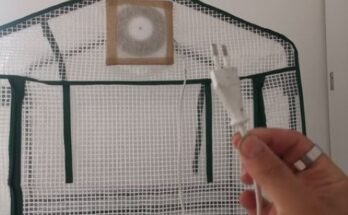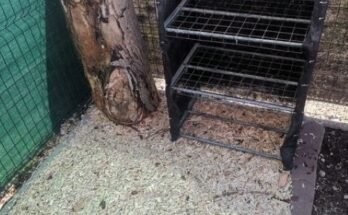Growing oyster mushrooms is not rocket science. It is a simple skill that you must learn carefully and practice to succeed. Cultivating oyster mushrooms can run into some troubles like any other crop or plant. But it should not discourage you to try growing your own oyster mushrooms. With a little troubleshooting you can avoid some of the common mistakes that you may be doing and make your oyster mushroom project a success.
It can be frustrating to invest a lot of time in cultivating mushrooms but still not getting any fruit. Well, it happened to me several times but I did not lose hope. I have always learned from my mistakes and tried not to repeat them.
Seven reasons your oyster mushroom is not fruiting
Oyster mushrooms need proper light, temperature, humidity, and fresh air throughout the growing process to fruit properly. In this post, I will share some of the common problems that you might experience while growing oyster mushrooms. I will also share the possible solutions to avoid these mistakes.
Let’s break into the details.
1. Moisture level is too low
Mushrooms naturally contain a lot of water. They require high humidity for their good growth. Mycelium “the vegetative growth of oyster fungus” needs a humid environment to thrive well and produce fruit. If the humidity level is too low the pins will not form and the one that manages to form somehow will dry out soon and abort.
I grew oyster mushrooms on sorghum waste in plastic bags during this summer and I went away for a few days and completely forgot to care for my mushroom project. When I came back everything dried out due to the hot summer temperatures. I was really frustrated to see my hard work wasted. But I tried again and created an all-new project. This time I provided proper humidity and moisture to the growing mycelium and my effort did not go in vain. I was delighted to see that the beautiful oyster mushrooms started growing out of the bags in a couple of months.
Always pay close attention to moisture and humidity levels. Keep misting when you feel the things are drying out. If you are cultivating under sterile conditions, then you will need to check the moisture and humidity levels carefully. You can use a cheap hygrometer to measure the level of humidity in the growing room.
2. Moisture level is too high
Though mushrooms need plenty of moisture, however too much moisture can also cause trouble. It can result in a soggy substrate with moldy growth and standing water. Standing water encourages the growth of molds and bacteria. These molds and bacteria compete with the oyster mushroom mycelium and do not let it grow. As a result, the mycelium becomes defective and fails to produce any fruit.
Never leave your substrate standing in too much water. No matter whatever the material you are using for growing oyster mushrooms always ensure good drainage. Do not let your mushroom sit in an area that has standing water and can increase the risk of mold growth.
3. Poor ventilation
Mushrooms do not need as much air as we humans do. But they still need some fresh air for their normal growth and fruiting. If the mushroom growing rooms are poorly ventilated, then carbon dioxide levels will increase in the rooms. Due to a lack of fresh air, the fruit body begins to grow long stems with small or no caps at all. If it happens the remove the entire flush by twisting off, move the bags to a suitable environment, and wait for the next flush.
Always make sure the area where you are growing your oyster mushrooms have enough flow of fresh air. I am growing my oyster mushrooms in a properly ventilated room with a couple of windows and an exhaust fan installed that allows the circulation of fresh air. I open the windows several times a day for a few seconds some to let the air circulate through the growing room.
If you are growing in a closed room then you must open the room’s door few times a day to let the fresh air in. But make sure not to open the rooms for too long as it can increase the risk of contamination and also reduces the humidity levels. As I did with my mushroom project, you can also install exhaust fans to improve air circulation.
4. Old and weak strain or spawn
While growing oyster mushrooms we might not think that the spawn can be a possible reason behind a mushroom’s inability to fruit. Spawn that is too old or has been stored for a long time might not be as vigorous and may fail to produce fruit. You should always use fresh spawn to increase the chances of getting a healthy crop. Look for a younger spawn with known vitality and history.
Always buy spawn from a trustworthy oyster mushroom dealer. If you will purchase spawn from a person with an unreliable business, then you might get low-quality spawn.
I advise you to use spawn soon after you purchase. Do not store it for long as it will lose its vigor over time and will become contaminated.
5. Growing conditions are not sterile enough
If you do not ensure sterile conditions in the growing room the mycelium will fail to produce any fruit. Oyster mushroom mycelium should grow and take control of the substrate. If you do not ensure sterile conditions the mycelium will lose its battle to molds and other microbes.
In an unsterilized room, all other types of microbes or molds will grow and take control of the substrate making your project a failure. Even if a contaminated bag of oyster mushroom produces fruit you will not feel like eating it.
Keep cleaning the growing rooms or outdoor beds to ensure a sterile environment. Wash your hands properly and avoid working close to the litter or trash bins. One of the preliminary steps is to ensure sterile conditions is to pasteurize the substrate and discourage microbial growth.
To ensure sterile conditions it is often necessary to get equipment like an autoclave, flow hood, or pressure cooker. However, it will be costly and unaffordable for most of mushroom growers. Moreover, it also requires training and practice to operate such equipment.
You can wipe the benches or the place where you are keeping the mushrooms with 70% ethyl alcohol. Too much moisture results in soggy walls that promote mold growth on the walls. I will share something with you based on my personal experience. When I was misting the bags to maintain humidity levels in the growing room I noticed that the walls of the room became damp and were soon covered with greenish mold growth. I painted the walls with lime paint that really helped me to deal with this problem. Lime paint contains calcium hydroxide and calcium carbonate that have antimicrobial properties. You can also give it a try!
6. Wrong growing conditions
The key to getting a successful crop from your oyster mushrooms is to cultivate them in the right environment. Every mushroom species has its own specific requirements for temperature and substrate. Make sure you know all the details about the type of mushroom you are planning to grow. It will help you to create an environment that is conducive to growing your desired mushrooms.
Don’t try to cultivate a warm-temperature oyster mushroom in cold weather. Oyster mushrooms are of two types based on temperature requirements 1) warm weather varieties that need 50 to 75 ℉ and 2) cold weather varieties that need 50 to 60 ℉. You must be familiar with the type of oyster mushroom you are growing.
Some mushrooms love to grow on wood logs so if you try to cultivate them on straw you might not get any results. Make sure the substrate you are using is suitable for your oyster mushrooms and has enough nutrients. Read about Substrate types for Oyster Mushrooms here.
Always do a little research before starting your project. You do not need a lot of knowledge or read a lot of books or literature to start your mushroom project. A little knowledge through the internet can help to start your oyster mushroom project and get good results.
7. Lack of Patience
Oyster mushroom mycelium takes time to take cover the substrate completely. It is not a matter of seconds it will take several days. You must be patient and wait for the mycelium to cover the bags. Careful watching and patiently waiting will be surely rewarded.
Be patient. If it looks like nothing is going to happen do not give up. Wait for a little longer. A little extra wait paid most of the time in my case.
I hope this article will help you to avoid the common mistakes that you may be doing while growing your oyster mushrooms. Learning how to grow oyster mushrooms successfully is not a complicated process a little troubleshooting can help you to get a good crop from your oyster mushrooms.




